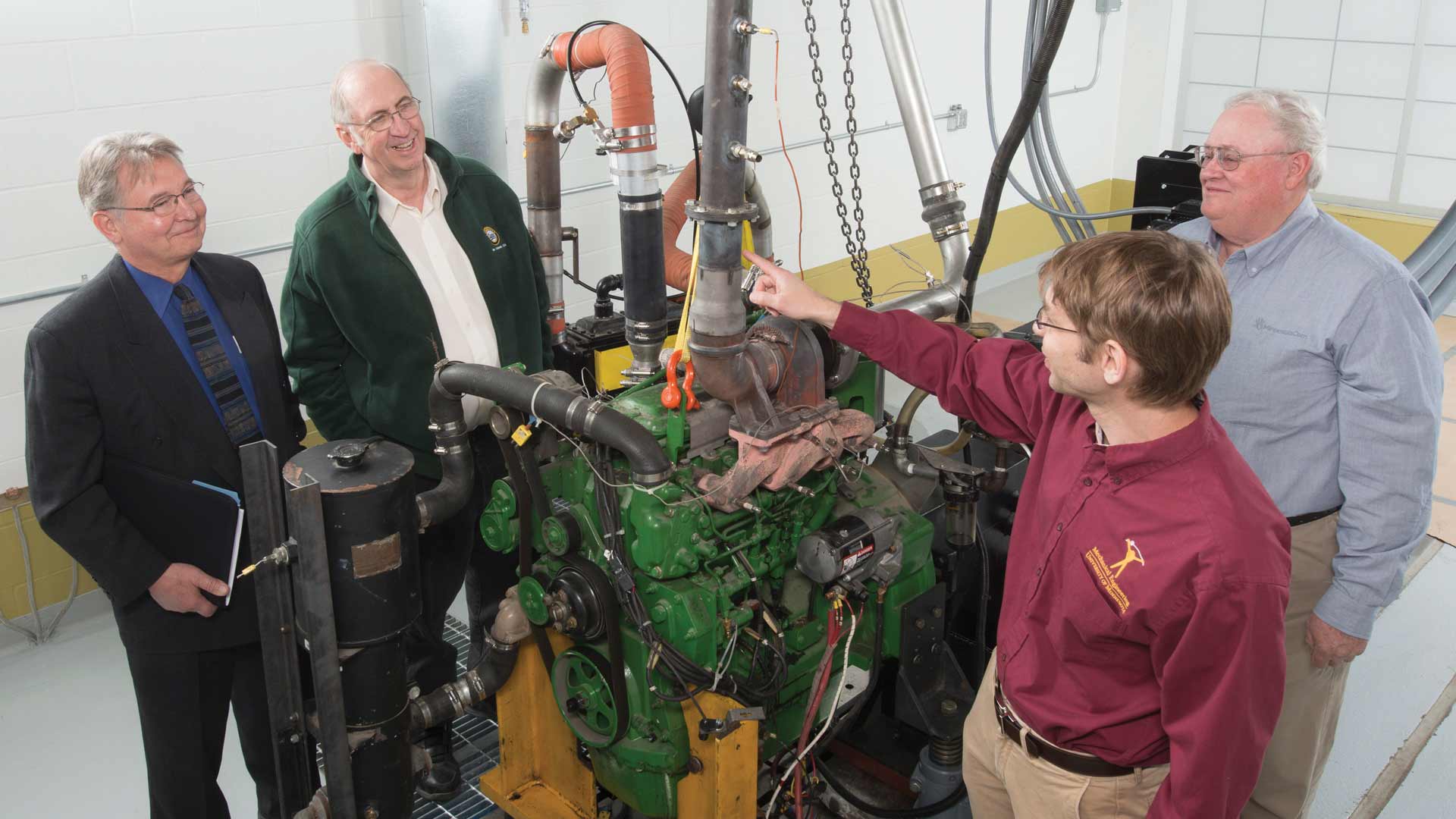–by Liz Morrison
A cheaper, cleaner diesel engine fuel is on the horizon.
Engineers at the University of Minnesota’s Center for Diesel Research are developing technology to use hydrous ethanol as the primary fuel in diesel engines. Hydrous ethanol contains more water than traditional anhydrous ethanol and costs less to make.
The research, supported by AURI and the Minnesota Corn Growers, could benefit the environment and the ethanol industry, as well as farmers and other diesel fuel users. Among the advantages of using hydrous ethanol in diesel engines:
- fewer harmful emissions;
- lower fuel costs;
- more net energy from ethanol;
- smaller carbon footprint; and
- expanded markets for ethanol.
“This could be a good win for agriculture,” says Rod Larkins, AURI senior director of science & technology.
Consumer research shows increased demand for homegrown renewable fuels with lower emissions. To help meet that demand and also create new markets for ethanol, corn growers are investing in research to develop new uses for the renewable, corn-based fuel. According to the federal Energy Information Administration, U.S. ethanol production is expected to reach 15 billion gallons this year.
Jerry Ploehn, a farmer from Alpha, Minnesota, who serves on the Minnesota Corn Research & Promotion Council says fueling diesel engines with hydrous ethanol could open up another large market for ethanol. In Minnesota, for example, replacing just 10% of diesel fuel with hydrous ethanol would consume 131 million gallons of ethanol—about 13% of the state’s current production.
More net energy, smaller carbon footprint, fewer emissions
Hydrous ethanol offers several advantages as a diesel fuel replacement, says William Northrop, an assistant professor of mechanical engineering at the University of Minnesota, who is leading the alternative diesel fuel research.
- Lower cost: It’s less expensive to make than traditional anhydrous ethanol, the fuel that’s added to gasoline. About 90% of distillation energy could be saved by using 160-proof hydrous ethanol, which is 80% ethanol
by volume. - Good for the environment: Total greenhouse gases emitted in the production of 160-proof ethanol are about 20% less than for traditional ethanol. Dual fueling with hydrous ethanol also cuts harmful diesel engine emissions, such as soot and nitrogen oxides, Northrop says.
“Our air is cleaner now because of ethanol,” says Richard Peterson, a corn and soybean farmer from Mountain Lake, Minnesota, who serves on the Minnesota Corn Research & Promotion Council and the AURI board of directors. “That’s one reason we are interested in this research.”
Two research projects explore dual fueling
Northrop is conducting two research projects to test the use of hydrous ethanol in diesel engines.
Study One: Proving hydrous ethanol can be used for fuel
In the first study, Northrop recalibrated an Isuzu 4HK1-TC diesel engine to burn two fuels. The engine uses an advanced fuel injection system called reactivity controlled compression ignition (RCCI).
One hundred sixty-proof ethanol was injected into the RCCI engine’s air intake manifold and was mixed with diesel in the combustion chamber, which allowed ethanol to be the primary fuel source.
“We showed we could get 85% of fuel energy from hydrous ethanol” in an RCCI engine, Northrop says. “This is much higher than what’s been achieved in the past.” In addition, Northrop says, emissions were kept below the EPA’s Tier 4 standards for off-road engines—with no loss of fuel economy or engine performance.
Study Two: Creating an aftermarket retrofit system
RCCI dual-fuel systems would need to be implemented by engine manufacturers, Northrop says. But until demand for dual-fuel-mode engines actually exists, he says, engine makers are unlikely to respond with new products. “That’s why we are going for an aftermarket retrofit system.” The question is: “Could we achieve similar emissions improvements with an add-on system” for older diesel engines?
That’s the goal of the second research project. Northrop’s team is developing a timed port-injection system that could deliver ethanol to a wide variety of existing diesel engines.
The initial research is being done on a 4-cylinder, John Deere 4045H Tier 2 diesel engine—a model that is widely used on farms. A timed port-injection system “will allow us to increase the amount of ethanol injected, realizing a more significant reduction in emissions,” Northrop says. That could eliminate the need for expensive particulate filters and catalytic devices to meet off-road emissions standards in older diesel engines.
On-farm uses promising
Dual-fuel-mode diesel systems require two separate tanks to deliver the fuel to the engine—one tank for hydrous ethanol and one for diesel. That’s likely to limit over-the-road applications, says AURI’s Doug Root, senior scientist of biomass & renewable products technologies.
Initial applications of dual-fuel diesel engines could be at ethanol plants themselves, Root says. Plants could divert hydrous ethanol during the distillation process and use it to fuel the ‘on-site’ diesel powered vehicles and back-up generators, cutting both processing and fuel costs.
On the farm, the technology would be a good fit for diesel tractors, harvesters and irrigator pumps, says Peterson, the Mountain Lake farmer.
“AURI sees the use of hydrous ethanol in off-road use of diesel fuel as a real opportunity for Minnesota agriculture,” concludes Root.
Idea to reality:
Minnesota corn growers are seeking new uses and markets for corn-based ethanol. Hydrous ethanol offers many advantages as a diesel fuel—if a reliable hydrous ethanol injection system can be devised for diesel engines.
AURI’s role:
AURI is helping to fund the research, is providing project management services and will identify field test sites for the new technology producing hydrous ethanol research.
Outcome:
In the first research phase, engineers showed that an advanced fuel injection system diesel engine can be operated on up to 85% hydrous ethanol without penalty in fuel economy or emissions. In the second phase, researchers are developing a hydrous ethanol, timed port-injection system that could be added to older diesel engines.
Partners:
University of Minnesota Center for Diesel Research; Minnesota Corn Growers Research & Promotion Council; CleanFlex Power Systems.
